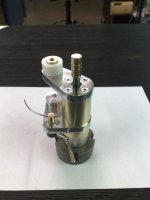Wand time
I just completed this arm base to go on my new Lenco, when i find the time to proceed with it.
After my lightweight arm this is truley a heavyweight!
I have a piece of timber big enough to get 2 wands out off, baring disasters and mistakes of course.
Planing on makeing a round section wand and a tapered semi square section wand, either will fit the arm Pillar, just to directly compare the 2 different wand shapes, though still a lot to do yet.
I just completed this arm base to go on my new Lenco, when i find the time to proceed with it.
After my lightweight arm this is truley a heavyweight!
I have a piece of timber big enough to get 2 wands out off, baring disasters and mistakes of course.
Planing on makeing a round section wand and a tapered semi square section wand, either will fit the arm Pillar, just to directly compare the 2 different wand shapes, though still a lot to do yet.
Attachments
Great work. The acrylic arm base is a nice touch. How did you get it buffed after the machining was done?
A friend with access to a large cnc machine made those arm bases for me
Although, perhaps materials such as aluminium and Delrin do have more self damping properties than brass or copper!
The speed of sound through different materials should perhaps be investigated.
In my experience copper is much more dead than is aluminum... ymmv.
Brass otoh is an alloy with different properties than either aluminum or copper. Also there are a range of "brass" alloys that vary considerably in terms of hardness and machinability.
Of course there is always the option of adding a dampening/absorptive material to any metal...
_-_-bear
Hmm, i beg to differ, i cannot imagine the sound of an aluminium bell!.
Bells are made from pure copper and tin, at the ratio of 14 to 4. and ring very nicely. Though aluminium will ring too if continually excited, though from a single tap the sound decays much faster.
Cymbals are also made from the same material, usualy B8 Bronze 92%copper and 8%tin. As the tin content in a bell or cymbal rises, the timbre drops. Guitar srtrings are also made of this material, commonly called Bronze, though more recently copper Alloy.
Bells are made from pure copper and tin, at the ratio of 14 to 4. and ring very nicely. Though aluminium will ring too if continually excited, though from a single tap the sound decays much faster.
Cymbals are also made from the same material, usualy B8 Bronze 92%copper and 8%tin. As the tin content in a bell or cymbal rises, the timbre drops. Guitar srtrings are also made of this material, commonly called Bronze, though more recently copper Alloy.
Last edited:
Hmm, i beg to differ, i cannot imagine the sound of an aluminium bell!.
No imagination necessary. Aluminum wind chimes are very common.
jeff
Nice, but i think you are missing the point, wind chimes are not made from aluminium because of its fantastic acoustic ringing properties
All materials can be made to ring, Wind chimes can be made from copper, glass, wood and ceramics, they all can be made to ring.
Aluminium in this case, is probably chosen not for its acoustic properties but because it is cheap.
All materials can be made to ring, Wind chimes can be made from copper, glass, wood and ceramics, they all can be made to ring.
Aluminium in this case, is probably chosen not for its acoustic properties but because it is cheap.
Nice, but i think you are missing the point, wind chimes are not made from aluminium because of its fantastic acoustic ringing properties
Not really. It's ok if you don't like them.
jeff
No imagination necessary. Aluminum wind chimes are very common.
jeff
...and so are aluminum Xylophone/Vibraphone/Marimba keys. What I heard though is that they all get treated with hippie voodoo before they'll actually ring!
Good evening  , (it is 22hoo in France!
, (it is 22hoo in France! ) I just finished my draft board after my "clone" schroeder arm, I have not tried it yet, it will come in the coming days ...DIY platine vinyle : Réalisations personnelles - DIY - Page 21 (sorry for my bad english !
) I just finished my draft board after my "clone" schroeder arm, I have not tried it yet, it will come in the coming days ...DIY platine vinyle : Réalisations personnelles - DIY - Page 21 (sorry for my bad english ! )
)
 )
)Attachments
- Home
- Source & Line
- Analogue Source
- DIY Schroeder Tonearm???


